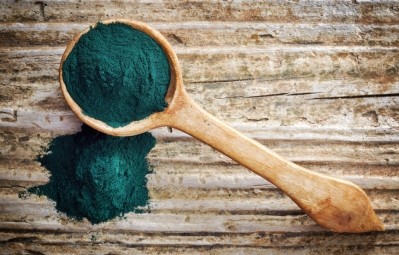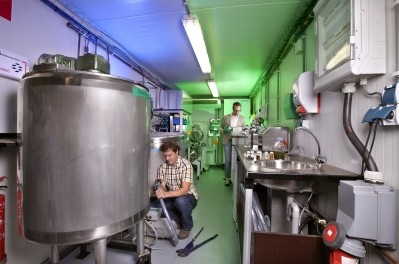‘We want to democratise spirulina’, says blue water start-up

The company said it was going for broad health and wellness appeal with the still water – which gets its colour from an extract of the blue-green microalgae spirulina.
Founded in 2012 by three school friends now in their mid-20s, the Paris-based firm used an extract because of the bad taste and smell of high-protein ‘whole’ spirulina. While this extraction meant the protein
content was lost, Springwave can still carry two EFSA-backed health claims for vitamin B2, B12 and magnesium for oxidative stress and tiredness.
The firm's co-founder and chief technology officer (CTO), Mathieu Goncalves Alves, said it was not targeting the specialist nutraceutical market, but instead plugging a general idea which would appeal particularly to females.
“Our aim is to democratise spirulina. To do that you have to have a real target first because we have to penetrate the market, but after the objective of our drink is to address more people,” he told FoodNavigator at the industry event SIAL in Paris, at which the product won an award for innovation.
“We really think spirulina is a huge thing because of all the properties it naturally adds, our aim was to democratise it for everybody, so this is the reason why we didn’t want to go to a market that was too narrow.”
Part of this process would be to educate consumers on what spirulina was, and why the company could claim ‘natural’ on pack despite its seemingly artificial bright blue colour.
Taste, smell and consumer perception
Asked if many consumers knew what spirulina was, he said: “We have a lot of questions like: ‘Oh my god how can it be natural it’s very blue’. So this is why we put ‘naturally blue’ on the packaging.”
Goncalves Alves said spirulina in its ‘whole’ form was rich in amino acids and protein – containing 70% protein compared to the 20% found in beef – which made the drink taste bad and meant a protein drink was off the cards.
“The main problem with spirulina is its taste and its smell. So our idea was to use an extract of the spirulina, and this extract gets rid of all the parts of the spirulina which makes a bad taste and bad smell and we only keep actives and the elements which are not smelly and so on.”
The founders – an engineer, business and finance graduate – recruited the help of the French National Centre for Scientific Research (CNRS) and a biologist to formulate the drink with water, flour, fruit extract and spirulina’s naturally occurring blue pigment phycocyanin.
The result was a formulation that could carry the health claims “contributes to a reduction of tiredness and fatigue” for magnesium and vitamin B2 (riboflavin) and B12 and “contributes to the protection of cells
from oxidative stress” for magnesium and vitamin B2 according to article 13 of the European Regulation (EC) No 1924/2006.
‘This is not a sports drink’
However, he said the product did not have enough active ingredients to target the nutraceutical market.
“This is not a sports drink. It’s more for the women, who take care of themselves. It was funny to find that women liked our packaging a lot, I think it’s because it’s very slim and practical.
“So it’s more for the day, and during the day you put it in your bag and you consume it when you want.”
He said the company was looking into the possibility of a sports nutrition product for its next drink.
Urban places
Currently it was targeting spa retail channels, however it was in talks with a French distributor to get into more “urban places”. He added: “We have to go at the right speed, not too fast and not too slow.”
He said the next stop beyond France would likely be the US, where the functional beverage market was more developed, particularly in places like the West Coast as well as New York.
The company had someone working on whether the product in its current form would fall in line with US regulation. “All are components have been approved by the FDA [the US Food and Drug Administration], we have to check the claims are too but I think that’s going to be okay.”
In Europe novel food approval was deemed unnecessary for spirulina since it was on the market before the cut-off date of May 1997. Meanwhile in the US it gained a Generally Recognised as Safe (GRAS) stamp of approval from the FDA as a source of blue colour for confectionery last August, following a petition by Mars.
The French connection
Springwave sources its spirulina from the French project LDC algae, based on the Atlantic coast. Goncalves Alves said France was a good place to source spirulina – with this organisation in particular planning to up production to around 2,500 tons a year. “This is sufficient for us. We are proud to have such a project in France and we have to support that.”
The word spirulina originates from the Latin meaning ‘spiral’ since the algae from the Lichinaceae family resembles a thin twined thread.



























